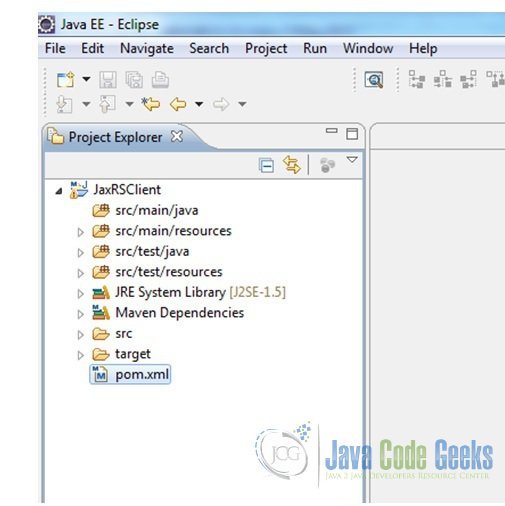JAX-RS Client Example
1. Introduction
In this article we are going to present an example code of writing a JAX-RS Client. As the reader would be aware JAX-RS API is a standard to simplify the writing of RESTful Web Services and their clients in Java. This will be a Jersey Client and we will assume that we have a Server already set-up that would intercept and respond to the requests fired from our Client. The entire code is available for download at the end of the article.
2. Project Set-Up
We will set-up a Maven project from the Eclipse IDE. Steps are as shown in the screenshots below.
- Start-up Eclipse and then go to File->New->Project…
- From the wizard that comes up choose the creation of a Maven project and then click Next
- The next wizard screen should be as shown below. Note how we have selected the creation of a simple project.
- In the following wizard screen just fill in the details as shown here and then click Finish.
- Finally we will have the following project structure

Fig. 3 Final project structure - Create an appropriately named package inside src/main/java, add
jaxRSClientExample.javaclass to it and we are good to go
3. Add Maven Dependency
We will use the latest version 1.19 of Jersey. Add the Maven dependency for Jersey-client in the pom.xml file
pom.xml
<project xmlns="http://maven.apache.org/POM/4.0.0" xmlns:xsi="http://www.w3.org/2001/XMLSchema-instance" xsi:schemaLocation="http://maven.apache.org/POM/4.0.0 http://maven.apache.org/xsd/maven-4.0.0.xsd">
<modelVersion>4.0.0</modelVersion>
<groupId>com.javacodegeeks.example</groupId>
<artifactId>JaxRSClient</artifactId>
<version>0.0.1-SNAPSHOT</version>
<properties>
<jersey.version>1.19</jersey.version>
</properties>
<dependencies>
<dependency>
<groupId<com.sun.jersey</groupId>
<artifactId<jersey-client</artifactId>
<version<${jersey.version}</version>
</dependency>
</dependencies>
</project>
4. Write Client Code
As stated above it is assumed that we have a Server up and running. In the below section we are going to write Client code to make a get and post request to it in jaxRSClientExample.java.
- First, create a ‘Client’ instance
- From the Client instance, obtain an instance of a WebResource. It is used for building requests and sending it to the Web Resource and then processing the response obtained.
- Next, we create a ClientResponse object which will hold the response obtained from the Web Resource
4.1 GET Request
The following code demonstrates a GET request
getRequest
package com.javacodegeeks.rest.jersey.client;
import com.sun.jersey.api.client.Client;
import com.sun.jersey.api.client.ClientResponse;
import com.sun.jersey.api.client.WebResource;
public class jaxRSClientExample {
Client client = Client.create();'
//set the appropriate URL
String getUrl = "http://localhost:8080/JAXRS-JSON/rest/student/data/get";
public static void main(){
getRequest();
}
public static void getRequest(){
WebResource webResource = client.resource(getUrl);
ClientResponse response = webResource.accept("application/json").get(ClientResponse.class);
//a successful response returns 200
if(response.getStatus()!=200){
throw new RuntimeException("HTTP Error: "+ response.getStatus());
}
String result = response.getEntity(String.class);
System.out.println("Response from the Server: ");
System.out.println(result);
}
4.2 POST Request
The following code snippet demonstrates a POST request. Notice that we are posting a JSON object to the server.
postRequest
package com.javacodegeeks.rest.jersey.client;
import com.sun.jersey.api.client.Client;
import com.sun.jersey.api.client.ClientResponse;
import com.sun.jersey.api.client.WebResource;
public class jaxRSClientExample {
Client client = Client.create();
//Set the appropriate URL for POST request
String postUrl = "http://localhost:8080/JAXRS-JSON/rest/student/data/post";
public static void postRequest(){
WebResource webResource = client.resource(postUrl);
String inputData = "{\"firstName\":\"Alice\",\"lastName\":\"Brown\",\"school\":\"Bright Stars\",\"standard\":\"Three\",\"rollNumber\":1212}";
ClientResponse response = webResource.type("application/json").post(ClientResponse.class,inputData);
if(response.getStatus()!=201){
throw new RuntimeException("HTTP Error: "+ response.getStatus());
}
String result = response.getEntity(String.class);
System.out.println("Response from the Server: ");
System.out.println(result);
}
public static void main(){
postRequest();
}
5. Outputs
Bring up the server and then fire the requests from the client. And one should see the outputs printed on the console.
5.1 Output from GET Request
Response from the Server:
{"firstName":"Elizabeth","lastName":"Hayden","school":"Little Flower","standard":"One","rollNumber":1113}
5.2 Output from POST Request
Response from the Server: Record entered: Alice Brown is a student of standard Three at Bright Stars
6. Download the Eclipse Project
This brings us to the end of this article. Hope it was an interesting and rewarding read.
You can download the full source code of this example here : JaxRSClient





